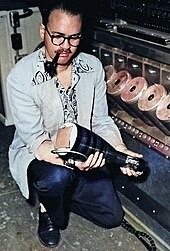
Back أنبوب ويليامز Arabic Лампа на Уилямс Bulgarian Tub Williams Catalan Williamsröhre German Tubo Williams Spanish لامپ ویلیامز Persian Williams-putki Finnish Tube de Williams French Tubo Williams Italian ウィリアムス管 Japanese



| Computer memory and Computer data storage types |
|---|
| Volatile |
| Non-volatile |
The Williams tube, or the Williams–Kilburn tube named after inventors Freddie Williams and Tom Kilburn, is an early form of computer memory.[1][2] It was the first random-access digital storage device, and was used successfully in several early computers.[3]
The Williams tube works by displaying a grid of dots on a cathode-ray tube (CRT). Due to the way CRTs work, this creates a small charge of static electricity over each dot. The charge at the location of each of the dots is read by a thin metal sheet just in front of the display. Since the display faded over time, it was periodically refreshed. It operates faster than earlier acoustic delay-line memory, at the speed of the electrons inside the vacuum tube, rather than at the speed of sound. The system was adversely affected by nearby electrical fields, and required frequent adjustment to remain operational. Williams–Kilburn tubes were used primarily on high-speed computer designs.
Williams and Kilburn applied for British patents on 11 December 1946,[4] and 2 October 1947,[5] followed by United States patent applications on 10 December 1947,[6] and 16 May 1949.[7]
- ^ Kilburn, Tom (1990), "From Cathode Ray Tube to Ferranti Mark I", Resurrection, 1 (2), The Computer Conservation Society, ISSN 0958-7403, retrieved 15 March 2012
- ^ Brian Napper (25 November 1998). "Williams Tube". University of Manchester. Retrieved 1 October 2016.
- ^ "Early computers at Manchester University", Resurrection, 1 (4), The Computer Conservation Society, Summer 1992, ISSN 0958-7403, retrieved 7 July 2010
- ^ GB Patent 645,691
- ^ GB Patent 657,591
- ^ U.S. patent 2,951,176
- ^ U.S. patent 2,777,971
© MMXXIII Rich X Search. We shall prevail. All rights reserved. Rich X Search